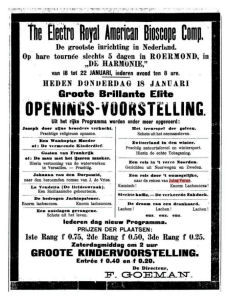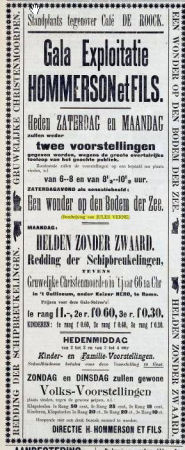From the archive
Click on the images to enlarge them.
The movie An impossible journey shown in 1906

The newspaper De Nieuwe Koerier (Roermond, The Netherlands) of 18 January 1906 contained an interesting advertisement which made us wonder about the early history of the cinema theatre in The Netherlands. In this ad, a cinema program is shown, with the names of 13 short films. Among these is An impossible journey based upon Jules Verne’s travels. This film of the French cinema pioneer Georges Méliès was at that moment less than two years old. The ad mentions that this film is a comic success, indicating that the slapstick element prevailed over the film’s technical merits and over Verne’s script. The ad made us wonder about the cinema / film theatres of those early days. What was “The Electro Royal American Bioscope Company”? Was it on a tour?
Early cinema theaters
Edison developed the first movie camera and projector, the kinetoscope in 1894. This was a viewer, through which one person at a time could see a moving picture. It came to Amsterdam in that same year. All those wishing to watch the 20 seconds’ movie had to pay f 0.10. Although this viewer was soon overtaken by the moving picture projector, the kinetoscope remained a standard attraction at Dutch fairgrounds until about 1900.
In 1895 the first moving pictures were projected in Berlin, where the brothers Max and Emil Skladanowski presented a 15 minute show titled Das Bioskop. Within two months, the Lumière brothers did likewise in Paris. An assistant to the latter showed these same films in Amsterdam within three months of their Paris première. The show lasted a half hour, the entrance fee was f 0,50. The first Dutch cinema operator was Christiaan Slieker (1861-1945). This Friesian fairground entertainer traveled from 1896 with his cinematograph between towns and villages. He had seen a kinetograph at the World Exhibition of Amsterdam in 1895 and subsequently purchased one in Berlin for the astronomical sum of 4800 German Marks. The first show of his Grand Theatre Edison was on the fair of Leeuwarden in 1896, after which he moved on to other places. Others followed in his footsteps. Until approximately 1910 movies were predominantly shown by traveling cinemas, initially in cafés, and at annual fairs, but gradually also in special movie tents or in rented rooms. The length of each film shown was maximally 30 metres. Eight to ten such films were shown every evening.
The Electro Royal American Bioscope Company was a Rotterdam-based traveling cinema, led by F.P.J. Goeman, who also ran the Tivoli-winter gardens there. In addition to Roermond (18-22 January 1906), it also visited Utrecht (12-15 October 1905), Nijmegen (16-23 September 1905) and Zwolle (2-9 December 1905).
The opening show of 18 January 1906 led to the following critique in De Nieuwe Koerier of the following day:
Bioscope.
These days, new cinematographic films are shown in the Harmony Room. This time by the Electro Royal American Bioscope Company, which our fellow citizens had reason to admire in a recent past. The program is completely new. The first show of Friday night unfortunately attracted few customers.
The show was not spoilt by blinding flickering pictures as is all too common. The program was carefully chosen for its variation. Humorous films, which made the spectators burst out laughing were followed by more serious pictures. The explanations of Mr. Louis Hartlooper, formerly active on stage, added to this impression, as did the excellent piano-playing. The appreciation expressed and the applause after each film illustrated to what extent the spectators were captivated by the beautiful colour shades in a number of the films.
Special mention should be made of the film based on Beyerleyn’s novel “Taptoe”, which had been object of a theater performance some time ago.
The website www.utrechtproject.nl provides under Bioscoopgeschiedenis (Cinema history) a list of the names of all ca. 40 known traveling cinemas, which were active in Utrecht in the period 1896-1914. Noteworthy is the fact that the Salvation Army had its own Bioscope Brigade as early as 1905.
On 6 October 1906, Gala Exploitatie Hommerson et Fils showed movies in Zaltbommel in a tent opposite Café De Rock. In the illustration below, Verne’s name is apparently out of place and used as a lure. At least it is doubtful whether the film announced here (A miracle on the bottom of the sea) was based on 20.000 leagues under the sea.

